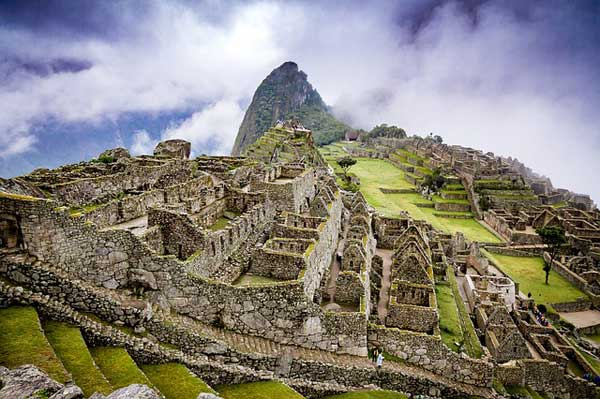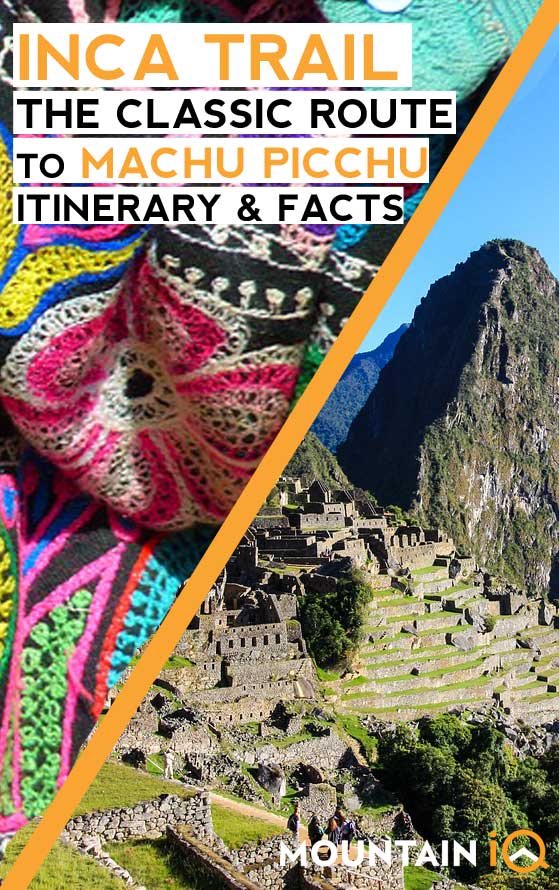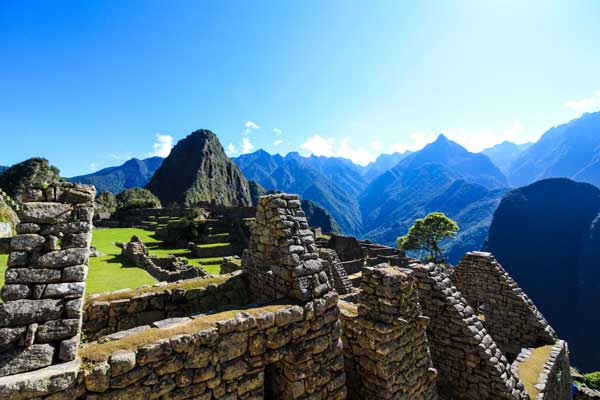The Classic Inca Trail is one of the most famous and popular treks in South America, it is visited by thousands of adventure-hungry tourists every year.
It was constructed by the Incas over 500 years ago and the Classic Inca Trail is the most famous stretch of the Inca road system.
The route is 45km long therefore you will be trekking 12km per day on average and will reach a maximum altitude of 4200m when passing through Dead Women’s Pass.
The trail is typically 4-days/3-nights long, but some people extend it to 5-days/4-nights to spend an extra night at Machu Picchu.
Classic Inca Trail Overview
The trek is fairly challenging. There are many steps which can take a toll on your knees, but a reasonably fit person should be able to cover the route.
Another factor which influences the difficulty of the trek is the altitude; this is a high-altitude trek and altitude sickness is a real risk.
Altitude sickness can affect you no matter what fitness level or age you are. It is important that you spend at least 2 days is Cusco acclimatising before you embark on the trail.
The trail is truly breath-taking, combining archaeological sites, amazing mountain scenery and lush cloud forest rich in Andean fauna and flora.
This route is an amazing choice if you seek both natural beauty and ancient history. It is rated as one of the best through hikes in the world.
The route typically departs from K82 and due to the popularity of the trek permits are required. Only 500 permits are issued per day, with only 200 permits being for tourists.
Permits sell out fast so you will have to book as far as 6 months in advance.
Inca Trail Quick Facts
- The Classic Inca Trail is easily the most famous trek in South America.
- The route was constructed by the Incas over 500 years ago.
- It is rated by many as being in the top 5 treks in the world.
- The highest point of the trail is Dead Women’s Pass at just over 4200m.
- The Classic Inca Trail is just a small portion of the 45000km network of Inca roads connecting the whole empire to Cusco.
- Friendly Llamas can be found along the route.
Check out more fun facts and figures about the Inca Trail.
Typical Machu Picchu Itinerary

Day 1: Cusco – Ollantaytambo – KM82 – Wayllabamba
Your journey will start with an early morning car/bus ride through the Sacred Valley.
After 3 hours, passing through picturesque villages, you will arrive at your starting point at K82.
The trail from K82 first crosses the Rio Vilcanota before climbing steeply from Rio Cusichaca to a small local village.
From this village, you will be able to see the Urubamba mountain range and will have a spectacular view of Mount Veronica.
On the other side of the village, you will see an Inca fort called Huillca Raccay as well as another Inca site called Patallaqta.
The route continues for another 7/8km to the small village of Wayllambamba situated at 3000m.
All in all, you will trek a relatively easy 12km on the first day.
Day 2: Wayllabamba – Llulluchapampa – Warmiwanusca (Dead Women’s Pass) – Pacamayo
Although you will be trekking the same distance as the previous day (12km), day 2 is the toughest day on the trail, mostly because you will be traversing through Warmiwanusca, situated at 4200m.
The beginning of the trail is straightforward.
After the first hour, you will reach a bridge that crosses the Huayruro River, there is a campsite here, which means bathroom facilities which may come as a welcomed relief.
From this point, the trail begins to steepen, passing through cloud-forest terrain before eventually reaching Llulluchapampa at 3680m after 3 hours of hiking.
From Llulluchapampa, you will hike another 1.5-2 hours before reaching Warmiwanusca, also known as Dead Women’s Pass, at 4200m.
You will be thankful to know that the pass isn’t named because a woman died, but rather because the slope of the mountain resembles a woman’s spine.
From Dead Women’s Pass, which is the highest point of the Classic Inca Trail, you will then descend for 2km down a steep trail to your campsite at Pacamayo.
Day 3: Pacamayo – Runkurakay – Sayacmarca – Phuyupatamarc – Winay Wayna
Day 3 is another challenging day, you will trek for 15km and traverse 2 small passes.
From Pacamayo, you will trek for an hour up to the ruins of Runkurakay and then after another hour you will reach the second pass on the trail, Runurakay Pass situated at 4000m.
From here, the trail consists of Inca trails and staircases. The first staircase from the pass is relatively steep, so make sure to watch your footing.
An hour along from the pass you will reach Sayacmarca, a beautiful Inca ruin, featuring a stunning stone staircase.
From Sayacmarca, the trail passes through an original Inca tunnel before climbing up to the third and final pass on the Classic Inca Trail. On a clear day you will have views of Salkantay in the south and Veronica in the north.
Just after the pass, you will reach Phuyupatamarc, one of the most impressive Inca sites on the trail.
The site is accessed via a steep pat that passes five original Inca baths.
Leaving the site, you will be presented with an original Inca staircase consisting of 1000 steps (this can be quite tough on your knees).
After 2-3 hours trekking through cloud forest you will reach the campsite at Winay Wayna, your final resting spot before reaching Machu Picchu.
Day 4: Winay Wayna – Inti Punku – Machu Picchu – Agua Calientes – Ollantaytambo – Cusco
Your morning will start early. You can either start at 4:30 (if you want to catch the sunrise over Machu Picchu) or 5:30.
You will trek 1.5 hours to Inti Punku (the Sun Gate). You may need to use a head torch for the initial part of the trip, although most tour operators only hit the trail after dawn breaks.
The trail from Winay Wayna runs through a cloud-forested contour path before reaching a steep flight of stone stairs.
At the top of the stairs, you will be treated to a view of the famous Machu Picchu. You will enjoy the view for about 30-40 minutes before taking a gradual path down to the citadel.
From here, you will register with authorities and store your backpack in storage.
Most tour operators include a 2/3-hour guided tour of the city before giving you free time to explore.
If you still have the energy, you have the option to climb Huayna Picchu (the mountain behind Machu Picchu). Huayna is often listed amongst the scariest hikes in the world.
You will have to book permits for this so make sure you book well in advance if you intend climbing.
Once you’re done exploring, you either need to catch a bus (generally included in the package) or walk down to Aguas Calientes.
The walk takes about 2 hours and boasts beautiful views.
From Aguas Calientes, you will travel back to Cusco, most likely via train, which will be organised by your tour operator.
Please Note: If you want to extend your trip to 5-days, you will spend the night in a hotel in Aguas Calientes.
Inca Trail Important Details
Best Time to Go
The best time to trek the Classic Inca Trail is in the dry season which runs from late April to early October.
It will be busiest between May and September, so if you intend on trekking during this time, make sure you book your permits at least 6 months in advance.
The dry shoulder months of March/April and October/November are also good time to trek, however the probability of rain during these months is higher.
December and January are incredibly wet, and the trail is closed during February for conservation and maintenance.
The temperatures are fairly consistent throughout the year with temperatures reaching the high 20s (Celsius) during the day and dropping to single digits or going below zero during the nights and early mornings.
Due to the presence of micro-climates it is possible for rain to fall any time of the year, even during the driest months, so make sure you pack wet weather gear just in case.
Difficulty
This trail is fairly challenging. It has a lot of stairs which can be tough on your knees.
You will also be traversing through 3 passes at a high altitude, so altitude sickness may make your trek more difficult.
This trail is very doable if you a reasonable amount of fitness and you have sent a couple days in Cusco acclimatizing.
Acclimatisation
The Classic Inca Trail reaches a maximum altitude of just over 4200 m, which makes the trek a high-altitude trek and therefore altitude sickness is a real possibility.
It is impossible to predict who is susceptible to altitude sickness as there is little correlation between age, gender, fitness levels etc and altitude sickness.
What is known, however, is that going too high too fast is a key contributing factor.
It is recommended that you spend at least 2 days in Cusco acclimatising.
However, because Cusco is already at 3400 m, if you’re traveling from sea level, it is very likely that you will experience mild altitude sickness.
It is important that you rest and drink lots of fluids to try to stave off the symptoms.
Make sure you know the risks, so you can take preventative measures against altitude sickness.
Permits
Due to the popularity of the trail, there are only a limited number of permits issued per day.
Only 500 permits are issued and only 200 of those are for tourists, the other 300 are for support staff.
Due to the lack of permits, you will want to book your permit 5/6 months in advance.
Permits go on sale at the end of each year for the previous year.
Inca Trail FAQ
Can you hike Inca Trail without a guide?
Unfortunately, you cannot trek the trail independently and your trip will have to be carried out in organised groups of visitors, a travel or tourism agency or with an official guide.
You can book your trip with one of the 175 officially licensed trail tour operators in Peru or with a larger international travel agency who have a partnership with a licensed operator.
Tour operators will organize everything for you; from booking your permit, to sorting you into groups and providing a guide.
The closest thing you will get to trekking independently is with an independent Inca Trail guide. This does mean that you will have to organise your trip yourself as well as carry your own belongings.
Is the Inca Trail difficult, do I need to be very fit?
This trek is fairly difficult, and a good level of fitness is required. You must be prepared physically and make sure you’re healthy prior to embarking on the trip, this involves working on your fitness and exercising regularly.
It is also important to be well acclimatised to lessen the likelihood of altitude sickness.
How long does it take to hike the Inca Trail to Machu Picchu?
The Inca Trail to Machu Picchu takes 4 days to complete.
How much does it cost to hike the Inca Trail?
It will cost you roughly $500-$700 to hike the classic Inca Trail. This covers transportation from Cusco to the trailhead, a guide, daily meals, permits and entry into Machu Picchu.
Will I be carrying my own belongings?
Normally, you will be required to carry your own belongings, however, f you book through an agency, a porter will carry items such as tents, food and cooking equipment.
You will also have the option of hiring an extra porter if you wish to have your belongings carried for you.
See our full Inca Trail Packing List for more details.
Will there be bathroom facilities along the trail?
Yes, toilets have been built along the trail, including major campsites.
Do you have any recommended guidebooks to read before hiking the Classic Inca Trail?
The Lonely Planet Peru Travel Guide is one of the most detailed, yet easy to digest guides to the Peruvian Andes and has most of the treks and routes in it, including the Classic Inca Trail.
Other Hiking Articles


